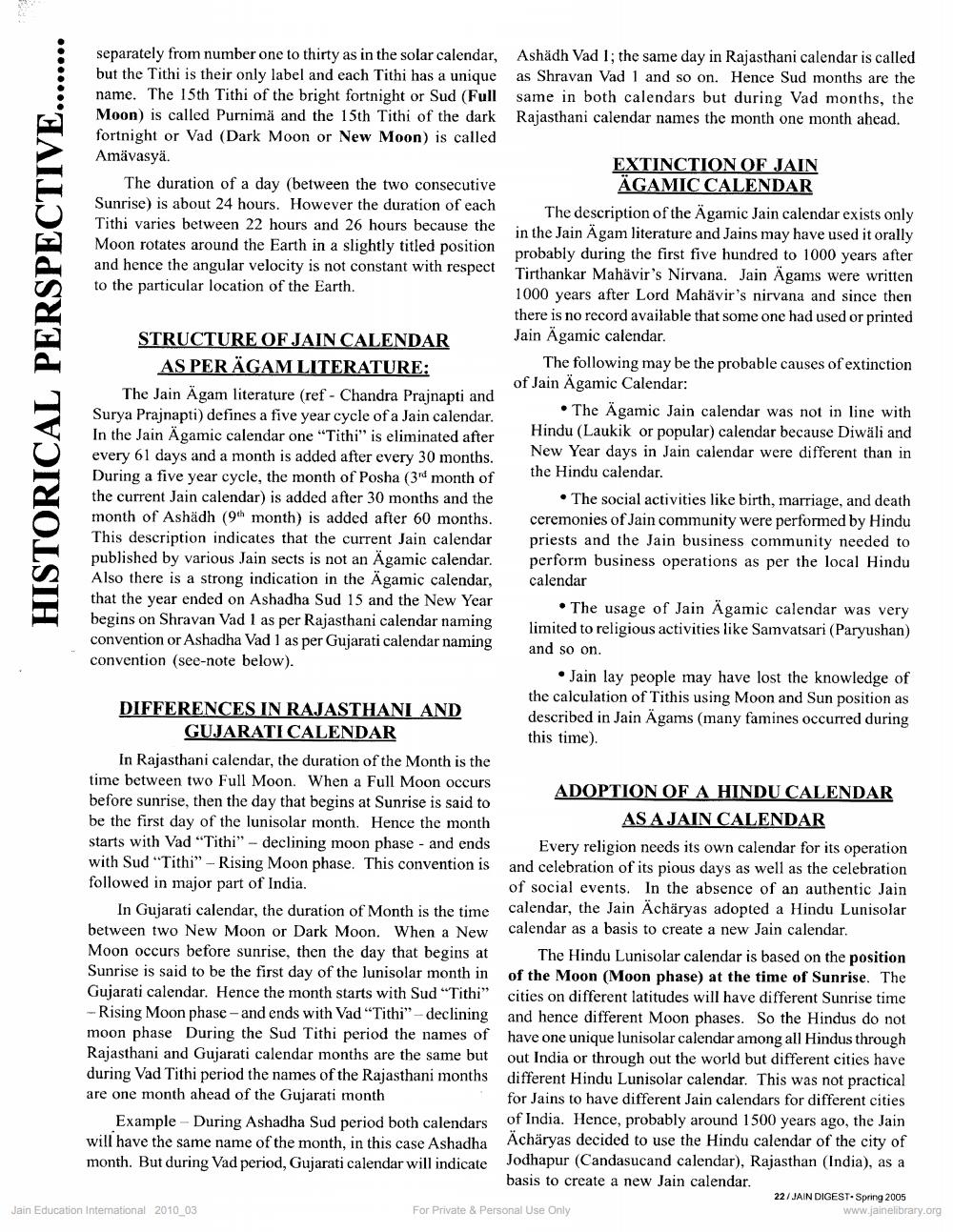________________
HISTORICAL PERSPECTIVE.
separately from number one to thirty as in the solar calendar, Ashädh Vad 1; the same day in Rajasthani calendar is called but the Tithi is their only label and each Tithi has a unique as Shravan Vad 1 and so on. Hence Sud months are the name. The 15th Tithi of the bright fortnight or Sud (Full same in both calendars but during Vad months, the Moon) is called Purnima and the 15th Tithi of the dark Rajasthani calendar names the month one month ahead. fortnight or Vad (Dark Moon or New Moon) is called Amavasyä.
EXTINCTION OF JAIN The duration of a day (between the two consecutive
AGAMIC CALENDAR Sunrise) is about 24 hours. However the duration of each
The description of the Ägamic Jain calendar exists only Tithi varies between 22 hours and 26 hours because the in the Jain Ägam literature and Jains may have used it orally Moon rotates around the Earth in a slightly titled position probably during the first five hundred to 1000 years after and hence the angular velocity is not constant with respect
Tirthankar Mahävir 's Nirvana. Jain Agams were written to the particular location of the Earth.
1000 years after Lord Mahävir's nirvana and since then
there is no record available that some one had used or printed STRUCTURE OF JAIN CALENDAR
Jain Ägamic calendar. AS PER ÄGAMLITERATURE:
The following may be the probable causes of extinction
of Jain Ägamic Calendar: The Jain Ägam literature (ref - Chandra Prajnapti and Surya Prajnapti) defines a five year cycle of a Jain calendar.
• The Ägamic Jain calendar was not in line with In the Jain Agamic calendar one "Tithi" is eliminated after
Hindu (Laukik or popular) calendar because Diwali and every 61 days and a month is added after every 30 months.
New Year days in Jain calendar were different than in During a five year cycle, the month of Posha (34 month of
the Hindu calendar. the current Jain calendar) is added after 30 months and the
• The social activities like birth, marriage, and death month of Ashadh (94 month) is added after 60 months. ceremonies of Jain community were performed by Hindu This description indicates that the current Jain calendar priests and the Jain business community needed to published by various Jain sects is not an Ägamic calendar. perform business operations as per the local Hindu Also there is a strong indication in the Ägamic calendar, calendar that the year ended on Ashadha Sud 15 and the New Year
• The usage of Jain Ägamic calendar was very begins on Shravan Vad 1 as per Rajasthani calendar naming
limited to religious activities like Samvatsari (Paryushan) convention or Ashadha Vad 1 as per Gujarati calendar naming
and so on. convention (see-note below).
• Jain lay people may have lost the knowledge of
the calculation of Tithis using Moon and Sun position as DIFFERENCES IN RAJASTHANI AND
described in Jain Ägams (many famines occurred during GUJARATI CALENDAR
this time) In Rajasthani calendar, the duration of the Month is the time between two Full Moon. When a Full Moon occurs
ADOPTION OF A HINDU CALENDAR before sunrise, then the day that begins at Sunrise is said to be the first day of the lunisolar month. Hence the month
AS AJAIN CALENDAR starts with Vad "Tithi" - declining moon phase - and ends Every religion needs its own calendar for its operation with Sud "Tithi" - Rising Moon phase. This convention is and celebration of its pious days as well as the celebration followed in major part of India.
of social events. In the absence of an authentic Jain In Gujarati calendar, the duration of Month is the time calendar, the Jain Acharyas adopted a Hindu Lunisolar between two New Moon or Dark Moon. When a New calendar as a basis to create a new Jain calendar. Moon occurs before sunrise, then the day that begins at The Hindu Lunisolar calendar is based on the position Sunrise is said to be the first day of the lunisolar month in of the Moon (Moon phase) at the time of Sunrise. The Gujarati calendar. Hence the month starts with Sud "Tithi" cities on different latitudes will have different Sunrise time - Rising Moon phase - and ends with Vad "Tithi" - declining and hence different Moon phases. So the Hindus do not moon phase During the Sud Tithi period the names of have one unique lunisolar calendar among all Hindus through Rajasthani and Gujarati calendar months are the same but out India or through out the world but different cities have during Vad Tithi period the names of the Rajasthani months different Hindu Lunisolar calendar. This was not practical are one month ahead of the Gujarati month
for Jains to have different Jain calendars for different cities Example - During Ashadha Sud period both calendars of India. Hence, probably around 1500 years ago, the Jain will have the same name of the month, in this case Ashadha Acharyas decided to use the Hindu calendar of the city of month. But during Vad period, Gujarati calendar will indicate Jodhapur (Candasucand calendar), Rajasthan (India), as a
basis to create a new Jain calendar.
22/JAIN DIGEST. Spring 2005 Jain Education International 2010_03 For Private & Personal Use Only
www.jainelibrary.org




